A comprehensive macaron troubleshooting guide with photos, possible causes and how to avoid the most common macaron issues!
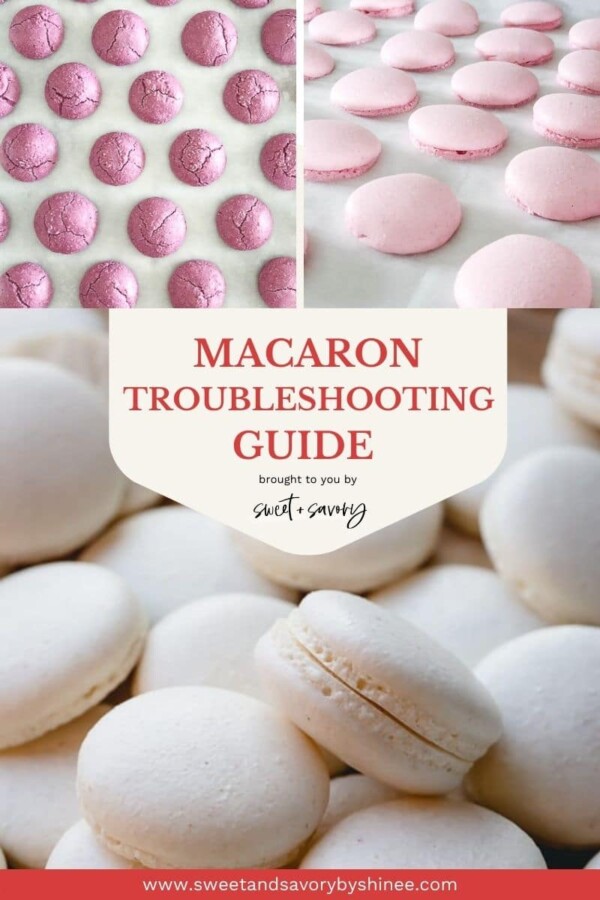
Table of Contents
Since 2012, I’ve made thousands of macarons in my home kitchen with many trials and errors, as well as picture-perfect macarons! And yes, I’ve had pretty much every problem imaginable!!
In the process, I’ve gained lots of tips and tricks to solve those frustrating issues and, most importantly, how to avoid them in the first place.
Remember, sometimes, macarons fail for no apparent reason and leave us scratching our heads.
But I encourage you to never give up on macarons. The joy of watching your macarons grow those ruffled feet and pulling out perfectly round macarons with shiny smooth tops is simply priceless.
I swear, every single time, when I see my macarons through the oven door puffing up and baking perfectly, I can’t help but do a little happy dance in my kitchen! Pure joy, I’m telling ya!
What’s a perfect macaron?
Perfect macaron is very subjective. To me, a perfect macaron has the following characteristics:
- Smooth shells
- Ruffles feet
- Full inside
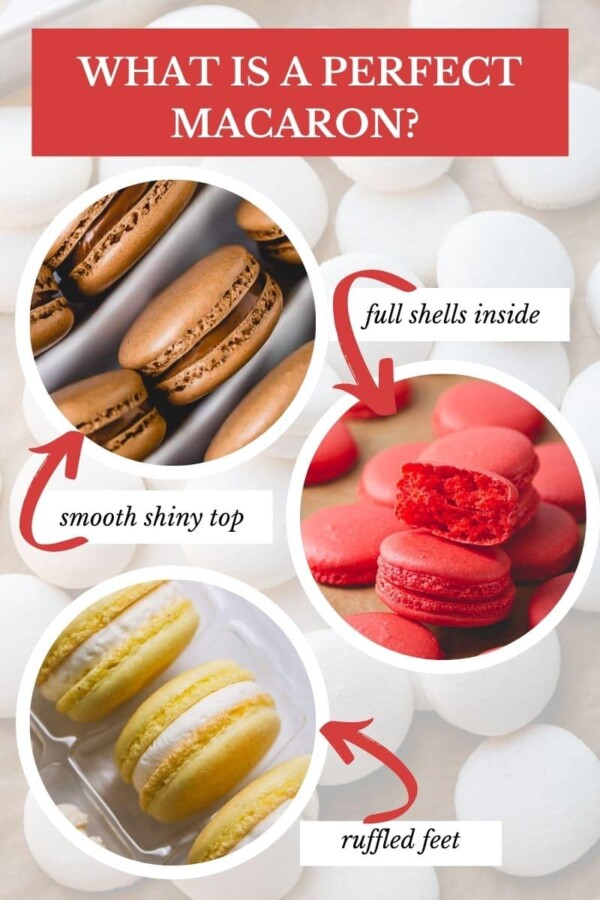
Macaron Troubleshooting Video
Visual Macaron Troubleshooting Guide
Ok, let’s discuss each of the most common macaron issues, their causes and how to fix or prevent them!
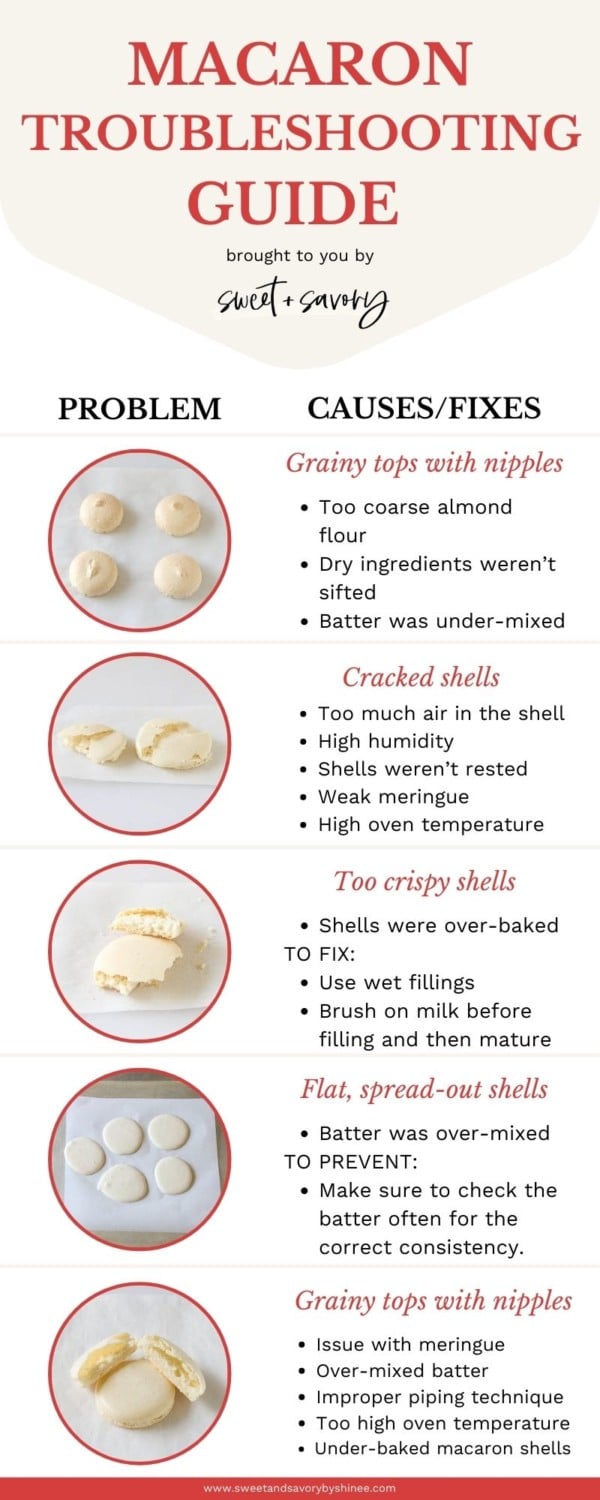
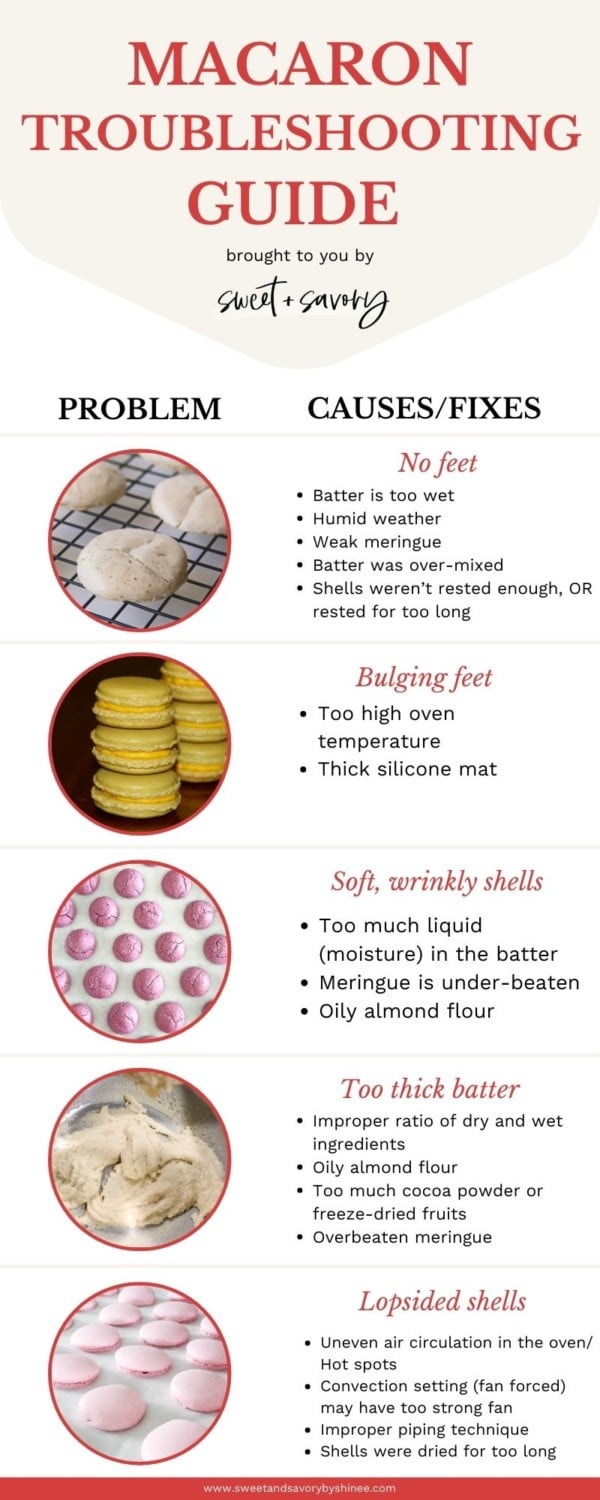
Pin this now to find it later
Pin ItUneven, grainy macarons with nipples
Possible causes:
- Too coarse almond flour
- Dry ingredients weren’t sifted
- Batter was under-mixed
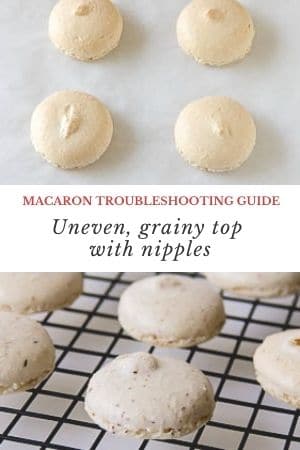
how to fix grainy shells with nipples:
- Make sure to use fine ground almond flour.
- Don’t skip sifting the dry ingredients! Toss large almond pieces left in the sifter. You shouldn’t have more than 1/2 tablespoon of almond bits.
- Under-mixed batter also causes grainy shells with nipples. When mixed right, the nipples should melt back into the batter after tapping the piped shells on the counter.
don’t do this!
Never use wet fingers to push the nipples down. Instead, use a toothpick to encourage the batter even out.
Cracked shells
Possible causes:
- Too much air in the shell
- High humidity
- Shells weren’t rested
- Weak meringue
- High oven temperature, or hot spots in the oven
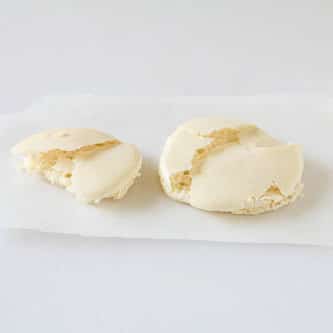
HOW TO FIX cracked macarons:
- Be sure to tap the baking sheet right after piping macaron shells. And use a toothpick to pop large air pockets visible on the surface.
- When it’s too humid, the shells don’t develop good skin, which leads to the next point.
- When the shells haven’t rested long enough to develop skin on top, steam releases from anywhere cause macarons to crack on top.
- Take your time to make nice and sturdy meringue, especially when you’re making French meringue. Watch my video on French Meringue 101 to learn all the tips to make the most stable French meringue.
- Too hot oven can also cause cracks in macaron shells. Make sure to get an oven thermometer to double check the temperature inside the oven without relying on what oven says.
Erupted shells
Possible cause:
- Touched the shells with wet finger to push down a pointy nipple
How to prevent erupted volcano macarons:
Never touch your unbaked macaron shells with wet fingers to push down pointy end. Instead tap the baking sheet well. And if the pointy end doesn’t melt into the batter, you can either baking them as is, or scrape the batter back into a bowl and mix for a little more until the batter is at correct consistency.
Too crispy interior
Possible cause:
- Shells were over-baked
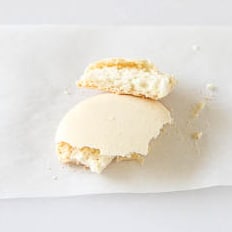
How to fix too crispy shells:
If you over-baked your macaron shells and now they’re super crispy throughout, don’t fret! 2 easy fixes:
- Use wet fillings, like jams, caramel sauce, or lemon curd in the center.
- Simply brush on milk on the bottom of the shells before piping a filling of choice.
Tip
Mature filled macarons for 24 hours. The shells will absorb the moisture from filling and macarons should soften nicely.
Flat shells, spread out too much
Possible cause:
- Batter was over-mixed
Over-mixed batter is too loose and the shells don’t hold its shape well, instead it spreads out too much.

How to prevent flat, spread out macarons:
Once macaron batter is over-mixed and it’s too runny, there’s no way to salvage it. So it’s important to prevent this from happening.
Make sure to check the batter often for the correct consistency. It should slowly run off the spatula into a ribbon, and the edges should melt back into the batter within about 10 seconds.
Hollow shells
Possible cause:
- Issue with meringue
- Over-mixed batter
- Improper piping technique
- Too high oven temperature
- Under-baked macaron shells
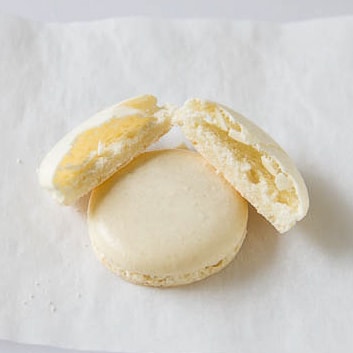
How to fix hollow macaron shells:
Hollow macarons are so common, and I personally battled with this issue for a long time. Now, I consistently get full, meaty macarons straight from the oven.
Since it’s a complex issue, I dedicated a separate post on how to fix hollow macarons.
No feet
Potential causes:
- Batter is too wet
- Humid weather
- Weak meringue
- Batter was over-mixed
- Shells weren’t rested before baking
- Shells were rested for too long, weakening the meringue structure
- Too low oven temperature
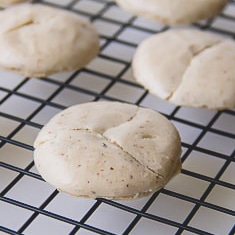
How to prevent no feet macarons:
- When the batter is too wet, macarons don’t develop those ruffled feet. The most common causes for wet batter: excess liquids, like extracts, lemon/lime juice, liquid food coloring, too much gel food coloring, etc.
- In some cases, especially in humid climates, aging egg whites might be beneficial. During aging, egg whites loose some of its moisture.
- When the meringue isn’t whipped to stiff peaks, it doesn’t have strong enough structure to lift macarons. Watch my French Meringue 101 video for visual cues for proper meringue.
- When macaron batter is over-mixed, there’s not much air bubbles left to give the shells lift during baking. Therefore, they come out flat without feet.
- Also, if macarons weren’t rested to form a skin before baking, it could cause no feet macarons. And if the shells were rested for too long, it can also negatively affect the batter, because meringue loses its stability when sat for too long. Keep checking the shells every 15 minutes and put them in the oven as soon as they don’t stick to your fingers.
- If the oven is not hot enough, macarons won’t rise as air bubbles in the meringue need heat to expand to lift the shells, creating that pretty feet at the base.
Tip
Make sure to get an oven thermometer to double check the temperature inside the oven without relying on what oven says.
Bulging feet
Potential causes:
- Too high oven temperature
- Silicone mat
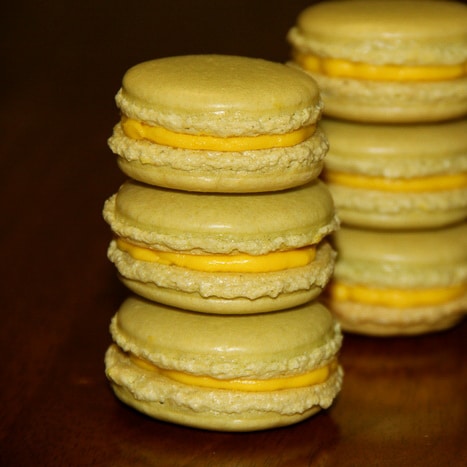
how to prevent bulging feet:
Some may find it ugly when the ruffled feet extends out of the macaron shells. I’m not a huge fan, but it’s not the worst!
- This happens when the oven is a bit too hot, causing the macarons to rise too high and then collapse slightly, making the feet bulge out.
- And another reason is silicone mat might be the culprit. I certainly happens to me with thick silicone mats, but I know some people have gorgeous macarons with silicone mats.
Soft, wrinkly shells
Possible causes:
- Too much liquid (moisture) in the batter
- Meringue is under-beaten
- Oily almond flour
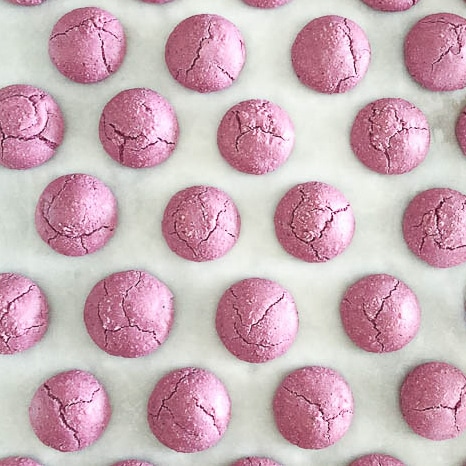
How to prevent soft, wrinkly shells:
Excess moisture and/or fat is the #1 cause for soft, wrinkly shells. And there’re number of culprits for excess moisture/fat in the batter:
- Adding liquid extracts, juices or liquid food coloring
- Adding cocoa powder, freeze-dried fruits, etc.
- Under-mixed meringue also contains too much moisture
- Oily almond flour, or almond flour that has been opened for too long
Cocoa powder contains fat which could potentially cause soft, brownie-like macaron shells. And freeze-dried fruits absorb moisture from the air fast and could cause soft, wrinkly shells as well.
Tip
Store opened almond flour in an airtight container in a cool place.
Too Thick batter
Typically, when you add dry ingredients into meringue, it starts out pretty thick and that’s totally normal. As you fold the batter, it thins out and gets runnier.
In rare occasions, the batter never loosens and it stays thick.
Possible causes:
- Improper ratio of dry and wet ingredients
- Oily almond flour
- Too much cocoa powder or freeze-dried fruits
- Overbeaten meringue
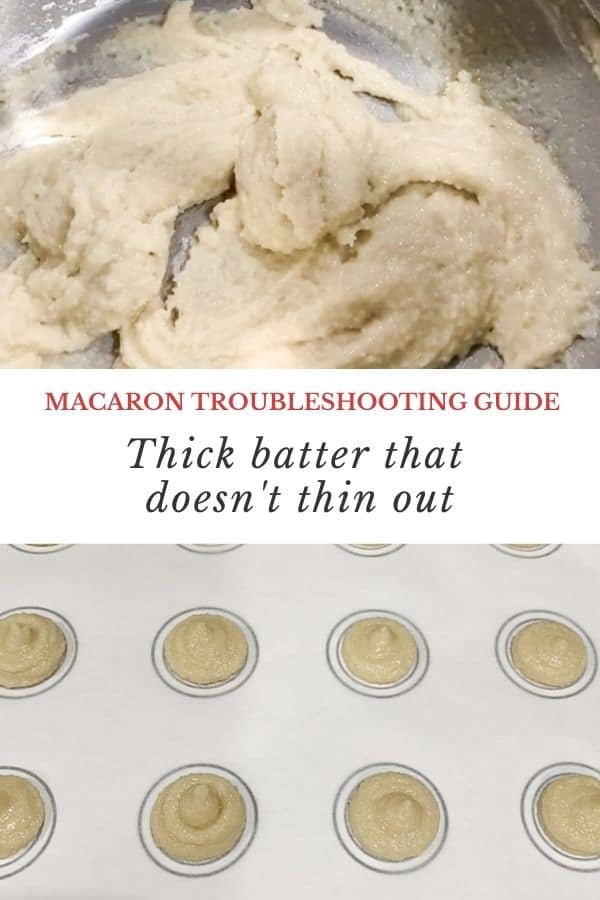
how to fix and prevent thick batter issue:
- Be sure to weigh the ingredients carefully. I strongly recommend weighing all the ingredients, including egg whites, with a kitchen scale.
- Oily almond flour could cause thick batter. Make sure to use fresh almond flour and avoid processing it in a food processor.
- Too much cocoa powder or freeze-dried fruits can throw the ratio of dry and wet ingredients.
- When meringue is over-beaten, it gets dry, throwing off the ratio as well.
Blotchy shells
I don’t have a photo of this issue, but basically it looks like greasy stains on the shells.
Possible causes:
- Oily almond flour
- Batter sat out for too long before piping
how to prevent blotchy macarons:
- Use fresh almond flour that’s not oily. To test, squeeze some almond flour in your hand and see if it holds its shape. If it holds its shape like wet sand, then it’s too oily.
- Make sure to pipe the shells right away, especially with French meringue batter.
Lopsided shells
Possible causes:
- Uneven air circulation in the oven/ Hot spots
- Convection setting (fan forced) may have too strong fan
- Improper piping technique
- Shells were dried for too long
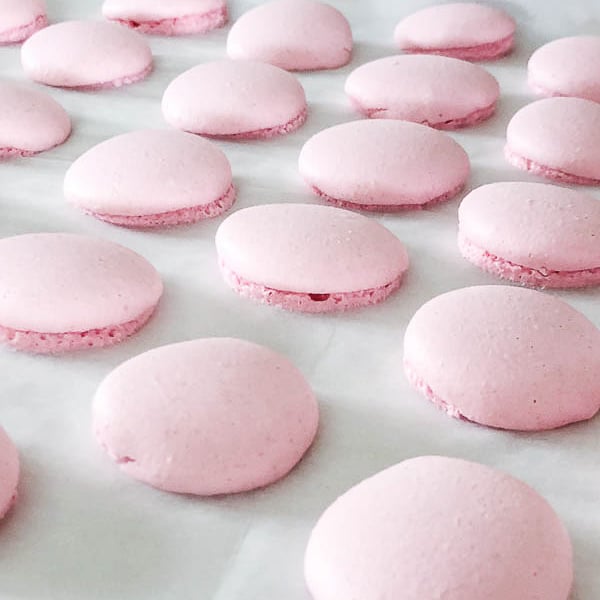
how to prevent lopsided macarons:
Main culprit for lopsided shells is poor air circulation. This could be due to uneven heat distribution and hot spots in the oven, convection settings with too strong fan. Here’re a few things you can do in this case:
- Flip the baking sheet upside down before piping macarons, so that there’s no edges around the sheet to block any heat circulation.
- Bake macarons one sheet at a time.
- Turn the baking sheet around half way through baking.
- If possible, bake on conventional setting, heat coming from top and bottom.
The next reason for lopsided macarons is improper piping technique. Pay close attention to following:
- Hold the piping bag with macaron batter straight at 90° and squeeze the batter from the top to one spot until the desired size reaches. Watch my macaron video for better illustration.
- Pipe the shells at least half an inch apart to give the shells enough room for air circulation.
And lastly, don’t dry your macarons for too long. Too thick skin may cause lopsided macarons.
Concaved (Inverted) shells or Stuck To Parchment
Possible causes:
- Low oven temp/ low heat from bottom
- Under-baked shells
- Not cooling the macarons before removing from parchment paper
How to prevent concaved, or stuck macarons:
- Make sure your oven is hot enough. Most of the time, ovens need good 30-45 minutes to preheat properly. Even if it beeps when it’s preheated, I highly recommend double checking with an oven thermometer.
- Be sure to check the macarons for doneness before taking them out. To test for doneness, gently touch the top of one macaron with your index finger and try wiggle it. If it wobbles side to side, they’re not ready. keep baking for another minute or so. The cooked shells should wiggle ever so slightly and firm to touch. When in doubt, cook a bit longer. In my opinion, it’s better to over-bake them than under-bake them.
- Make sure to cool the macarons on the baking sheet for at least 10 minutes before removing from parchment paper/silicone mat.

Whew, are you still with me? Thank you!!! I hope this macaron troubleshooting guide answers your questions and helps you to perfect your macaron skills.
And if there is anything I haven’t covered, please leave me a comment below. I’d like us, macaron-lovers, connect and discuss various problems we face baking macarons. Let’s get the discussion started.
More Favorites from Sweet & Savory
This post was originally published on December 21st, 2015, and last updated on February 16th, 2021.

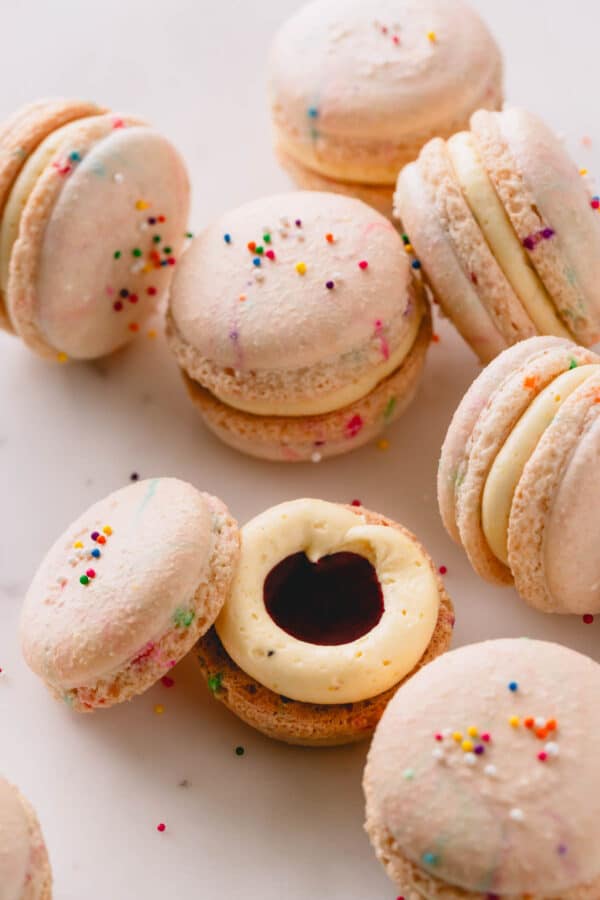
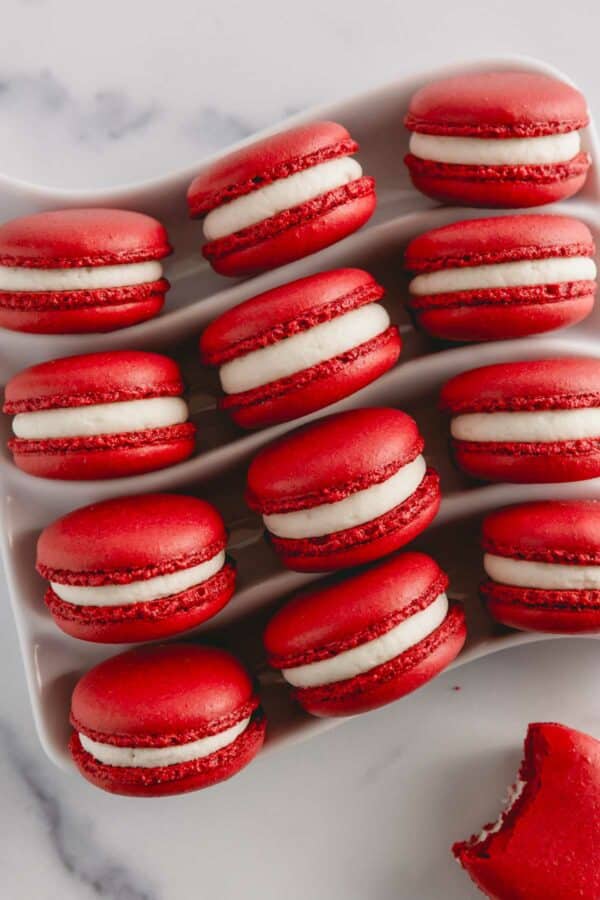
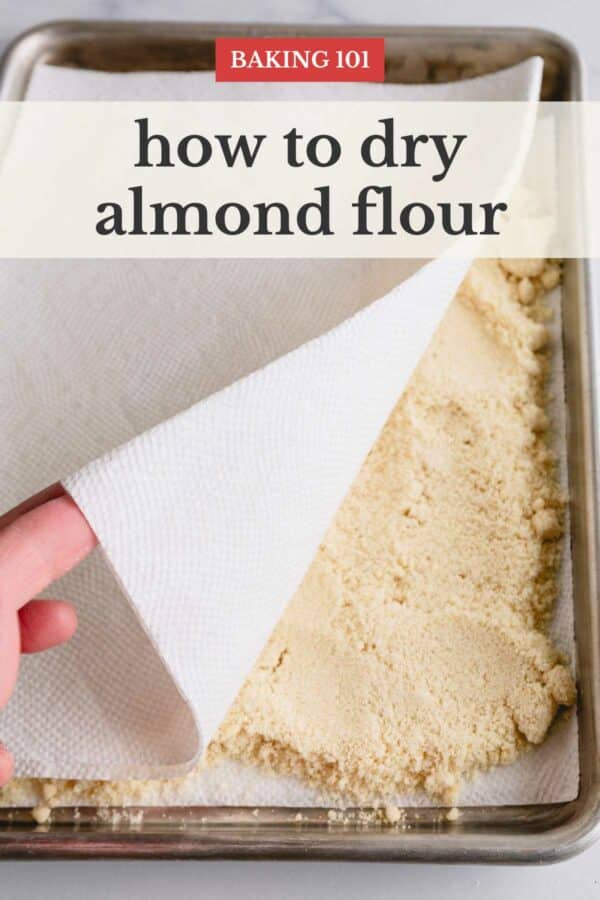
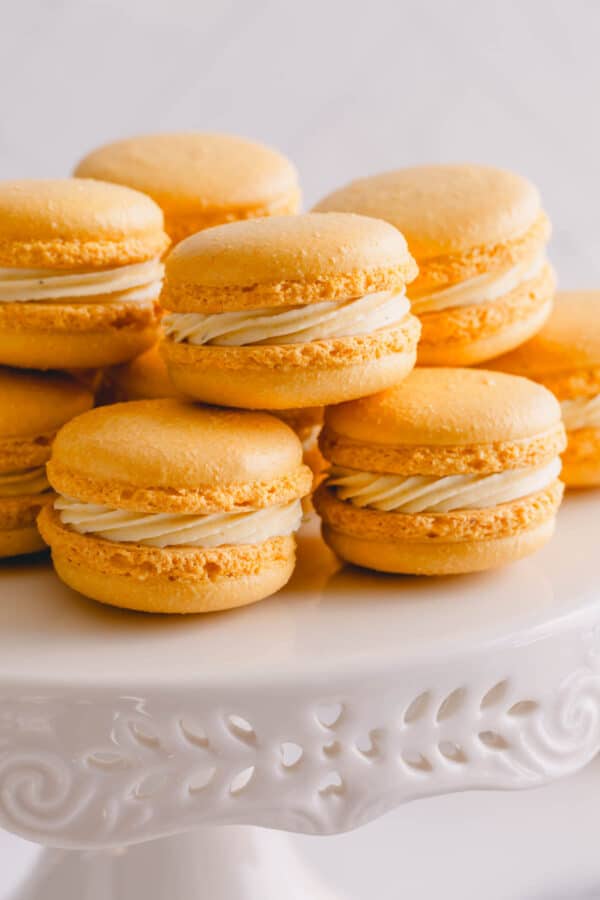

Hi , thanks for the tips .
I tried baking it twice , and my batch always gets fluffy in oven but then the top gets very thin and either (Mostly)cracks or get Very wrinkly.
Could you please help me understand what could be the reason. (My meringue had hard peaks and also batter was not runny )
Hi, Jayc. So those thin soft and wrinkly tops indicates excess moisture. It could be the moisture in the batter or in the environment, but most likely the batter.
Couple things that cause excess moisture in the batter:
1. Too much liquid flavorings such as vanilla extract, or liquid food coloring.
2. Too much egg whites. Make sure to weigh the egg whites as well.
My first try at macarons. They stuck to the silicone mat, and they were cooled off! I had to use a knife to release them, and they still stuck. What a mess. Of course the buttercream filling filled in the hollows that were left.
Hi, SF Seltzer. It sounds like your macarons were under-baked. I’d recommend baking them a couple minutes longer next time.
Hi Shinee,
I’ve been making macarons for some time and in my opinion, they come out of the oven looking perfect and tasting quite good but every single batch has come out with hollows. I use a stand mixer and am pretty sure that I am not overbeating my meringue. I have tried different temperature and time variations from 280 for 20 and 22 mins, 302 for 16 mins and 320 for 14 mins. I have ordered an oven thermometer to see if temperature is the reason for my hollows. However I read in one of your replies to another writer that you wouldn’t suggest opening the oven door at all and that it may be the cause for the macarons collapsing. In the recipe I am using, it says to rotate the baking tray half way through cooking for even baking. Could this be the reason for my hollows and would you suggest I stop doing this?
Hi, Katy. What method do you use for meringue? Italian meringue or french meringue? If you’re using french meringue method, I suggest to whip the meringue at a consistent speed the entire time. I whip my egg whites at speed 2 the whole time, and it’s been consistently delivering the most stable meringue and full macarons. Give that a try first. But I also recommend not to open the oven, it could definitely cause the collapse. Let me know if it helps. Thank you!
I am confused about your instruction with the eggs white. On one paragraph you say when the meringue reaches hard peaks, gradually reducing the speed and not just shutting the mixer off.stop.
On another paragraph you say when it reaches hard peaks then stop.
Can you please clarify? Thanks
Hi, Maria. Sorry for confusion. I suggest to gradually reduce the speed, instead of abruptly stopping the mixer. But that shouldn’t take very long, about 30-45 seconds slowing the speed down to stop should be good. Hope this clarifies. Let me know if you have any questions.
Hi there!
I’m having gear success with the texture and consistency of the shells, but I can’t stop the browning and the colour changing. Also, even if the colour works out ok, they look really dull and ever so slightly grainy. Not smooth and shiny like the pictures. I sift several times!
Thankyou!!
Hi, Jenny. First, browning issue: I’d suggest to play around with your oven temperature. It’s possible your oven runs a bit hotter. Try reducing the temp by 10-15°. Or you could place an empty baking sheet on top rack over the macarons, which will block the heat from the top. And as for smooth shells, I highly recommend getting “super fine” almond meal, which helps with texture. Hope these tips help. Please keep me posted.
Hi Shinee,
I baked my macarons yesterday and they came out beautiful. The taste was great and they had feet. But I noticed they had hollow shells and it was a bit crunchy. I don’t know what I did wrong though, I beat my meringue until they are at stiff peaks – about 6 mins. Can you help me how to fix the problem? Thanks.
Hi, Veronica. Congrats on your macaron success!! I think hollow macarons are pretty common issue among beginning macaron bakers. I know I used to have that problem all the time! And I still do from time to time. The biggest culprit to hollow macarons is over-beaten meringue. Another possible problem is your oven may run hotter and cook the shells fast on the outside, and when you bring them out, the inside collapses. I suggest getting an oven thermometer and check your oven temperature for accuracy. And also maybe play around with baking time and oven temp to find the sweet spot with your oven. Good luck!
I was wondering, I was told that the barometric pressure can be a hindurance to making Macarons and them turning out like they should. What should the barometric pressure be, or how high should it be. Thanks
Hi! I have looked all over for an answer to my macaron dilemma. I am hoping you can help. The issue I am experiencing over and over again is soft, paper thin, fragile macaron tops. I have tried EVERYTHING!! I have been told that this is caused from over mixing your batter. I am diligently checking to make sure that my batter is not over mixed and I even walk away from my batter for a few minutes when it looks almost perfect to wait to see if it actually needs any more turns. I use a le cordon bleu “fool proof” recipe and have tried countless others….still the same issue. How do I harden my macaron shells? Help, thanks.
Following. Im drying my 5th attempt. I watched so many videos. Tried different consistencys. But everytime i get smooth tops blown out feet and hollow insides. I havent eaten a macaron yet.
Hi, Christy. By blown out feet, do you mean they’re super tall, or bulging out ones? Either way, it sounds like the issue is over-beaten meringue. Hollow meringues are usually indication of over-beaten meringue, so is big feet. Hope this helps. And please don’t give up on macarons. Keep at it! 😉
Hi, Heather. Sorry I didn’t get back to you sooner. Are your macaron shells also wrinkly by chance? If the shells are soft, paper thin and wrinkly, the most likely culprit is excess moisture. Excess moisture can be due to added extracts, food coloring, humid climate or rainy day, etc. Here’re my suggestions: try baking your next batch on a dry day without any added extracts and food coloring. Let me know if that helps.
My 4th batch came out like that, so fragile you could just touch them and the tops would crack. They were mostly hollow too. I’ve figured out that I accidentally added too much extract, which started to break my meringue. I managed to salvage it and make a successful macronage, so I thought they’d be ok, but even though they looked pretty they were a disappointment. Two things helped my last batch be the closest to perfect yet – I followed a recipe that included exact times and settings for my mixer (Kitchenaid), and I measured MUCH more carefully. Some came out with cracked tops but the texture inside was perfect, but those were baked on a different pan and I think that was the cause. Keep trying, good macarons are totally worth it!
Thank you, Caroline, for sharing your experience!!!
Hi! So I just tried this recipe (first time making macs) I followed the recipe exact, except I did not use cream of tartar. I also added a drop of raspberry extract to the merengue with the food coloring. Let them sit for almost an hour. Set my oven to 300 and baked them for 20 minutes. The top was brown (almost burnt) and they never formed feet! The taste great though, but they look terrible. Any tips for my second time around? I will definitely need to take them out of oven sooner or bake at a lower temp. But what should I do different so they can form feet?
Hi, Maryorie. Thank you for your feedback and providing details. It sounds like your oven runs hotter than it’s set, which is very possible. I’d suggest getting an external oven thermometer to check for accuracy. For feet, it may be due to batter being over-mixed. When you piped the macarons, did they spread too much?
Hi please help me! I’m despairing and on the point of giving up! I think i’m in batch 40 or something and they are still failing. I am using the Italian method as French ones never work for me but I have had some success with the Italian. It seems that when I mix the egg with the dry ingredients.. Its like a VERY stiff dough. When I try to fold in meringue it’s impossible and all su sequent attempts fail with rubbish looking macarons as the batter never gets runny enough. No matter how much I mix it. So I try adding more egg white into the dry ingredients to make it softer. But I end up with cracked shells and ALL my macarons seem to come out wrinkly. I can’t do this any more! I need help!!!! Please advise me as to where I am going wrong. I really would appreciate any help you may give me x
Hi, Bethan. I’m sorry to hear your frustration!!! And I applaud you for your persistence and for not giving up! Can you please let me know following, so I can help you better to troubleshoot the issue?
1. How are you measuring the ingredients? By volume (cups) or by weight?
2. Is it humid where you live?
Adding more egg whites to thin out the macaron batter definitely won’t help. Wrinkly macarons with super soft wrinkled skin is the classic example of excess moisture in the batter, and it’s likely due to adding plain egg white to the batter.
I look forward to hearing back on those 2 questions and we’ll go from there.
I am not sure exactly what I did but I suspect undercooking even though the tops browned. Can I send you some pictures so you can tell me what you think? I have bottoms sticking to pan, kinda sticky interiors, some discoloration spots on the tops, and slightly hollow bottoms.